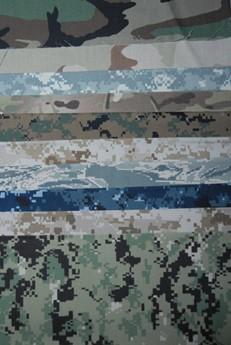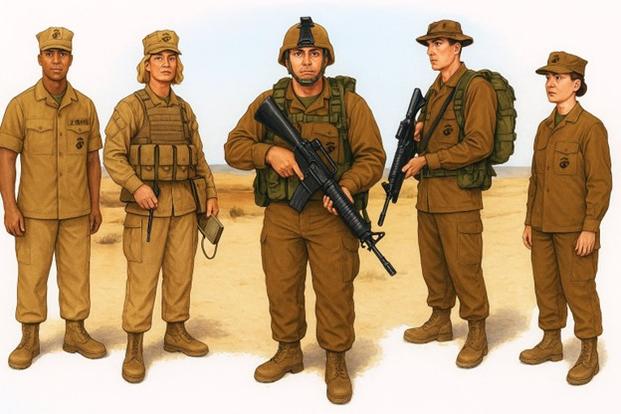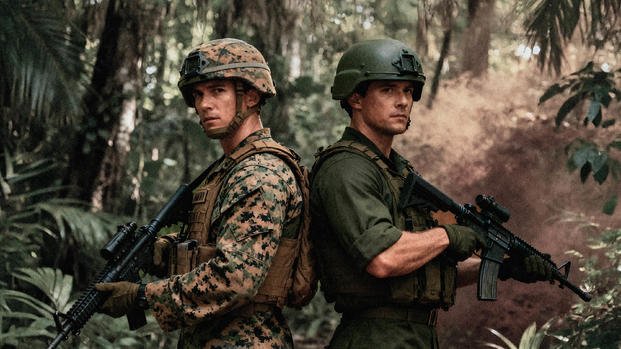First to fight. A mantra that defines the Marine Corps in everything it does, including its gear. For over 20 years, the Marines have proudly donned the digital MARPAT camouflage uniform. The pixelated design has become as iconic as the eagle, globe, and anchor. But after more than two decades, the pattern has arguably run its course. In an era of tight budgets and evolving threats, perhaps it is time to ditch the “digi’s” and return to something simple, such as a flat coyote brown (or even back to olive drab) utility uniform. Spearheading this effort could lead to mass adoption across the War Department and ultimately save money, streamline logistics, and set a practical example for the rest of the military. First, let's take a deep dive into how we got here.

MARPAT’s Development
The story of MARPAT can trace its roots to the work of famed camoufleur Timothy O’Neill, who proposed a similarly pixelated pattern known as “Dual-Tex” in the 1970s. While this design ruminated over the decades, by the late 1990s, the Marine Corps started looking for a replacement for the camo design it used throughout the 1980s and 1990s. Traditional camouflage was deemed sufficient, but advances in technology created a demand signal for something more effective. Inspired by the Canadian “CADPAT” design, which was built on the Dual-Tex research into digital patterns that used small pixels to break up shapes, the Marines launched their own development. By 2000, MARPAT (short for “Marine Pattern) would be developed and patented in woodland, desert, and urban designs (the urban would later be scrapped by the Corps). While many Marines hold to the notion that the pattern was the result of scientific testing by the Marine Corps, the reality is that it came down to field testing between tiger stripes and digital (with Commandant General Jones preferring the tiger stripe). Marine Corps Systems Command would ultimately go with the digital design that we know today after extensive field tests - though it has been argued that the design was more cosmetic than functional.
Adoption was well-received by the Marines. In 2002, the Marine Corps began replacing the old camouflage uniform (or “BDUs” as the Army called them, short for "Battle Dress Uniform"), and by 2004, the force was outfitted with the first service-specific pattern in modern U.S. military history. It was a bold move at the time that highlighted the Marine Corps’ independence and innovation. Soon after, other branches took notice and jumped on the digital bandwagon. The Army, with its moonscape-inspired “Universal Camouflage Pattern” in 2004 (which was criticized for poorly blending into Iraqi and Afghan terrains). Soon after, the other branches jumped on board with the Air Force releasing a pixelated tiger strip camouflage design and the Navy releasing the “blueberries” (or also referred to as “Aquaflage,” a blue version inspired by MARPAT). All branches would ultimately ditch their digital camo with the Army and Air Force converting to the multicam design over the past decade, and the Navy switching to a design that looks similar to the Marines’ MARPAT design.

The Cost of Change
This proliferation was not cheap. A Government Accountability Office report in 2012 highlighted how duplicative efforts led to fragmented development, with costs spiraling each time a branch reinvented the wheel. Estimated pegged replacing the Army’s uniform alone is at $4 billion over five years, not counting the millions already sunk into testing and production for patterns that overlapped in function. A critical perspective might call it a classic case of inter-service rivalry trumping efficiency, where ego and brand overrode efficiency and military uniformity. Bottom line: the Army and the Air Force spent billions on pointless uniform changes only to return to a style not unlike what they had less than a decade previous.

Switching back to a uniform look across the War Department will not be without its hurdles. The 2014 National Defense Authorization Act, passed by Congress, included a provision mandating that the branches stop creating new camouflage patterns unless they are joint efforts applicable across services. The law aimed to curb the very waste we had seen, requiring the Secretary of Defense to establish policies for unified combat uniforms by 2018. This meant any new design, even a solid color, would require approval to avoid violating the spirit of the law. This sensible guardrail, however, has complicated any quick changes for individual branches.
Yet in spite of this constraint, there is an opportunity for the Marines to lead from the front as usual. By ditching MARPAT for a single-color utility uniform like coyote brown (or even a throwback like olive drab), the Corps could pioneer a return to basics that’s both cost-effective and versatile. Coyote brown, a tan shade already heavily utilized in gear (such as plate carriers, packs, etc.), blends well in both arid zones and urban settings without the need for complex printing. Olive drab, another option, is tried-and-true; having been utilized in World War II, Vietnam, and other conflicts across the globe to tremendous effect in both forests and fields. Such a uniform transition choice would simplify supply chains, reduce manufacturing costs, and work in garrison or deployment; Marines could function effectively in combat, the field, turning wrenches in the rear, or even working behind a computer. Other branches would then be wise to follow suit, fostering joint uniformity consistent with congressional mandate.
From Concept to Reality

In the above concept art, the coyote brown presents a clean, rugged appearance that harkens back to a simpler time while incorporating modern fabrics for durability. It shows Marines operating in different configurations, blending seamlessly into any environment without the pixelated distraction. Proving that less can indeed be more.
Leading the Way
Marines are known for doing more with less, and this change embodies that ethos. It would honor traditions while adapting to fiscal realities, potentially saving billions across the War Department in the long run. Some will yearn for the digi’s unique look, but effectiveness trumps style. As threats evolve from dense jungles to urban sprawls, a versatile solid color is the smart move. The Corps led the way into digital camo; now it can lead us out.
UPDATE: Edited 8:35 AM EST, 30 October 2025, to include "BDU" as an Army specific reference.















